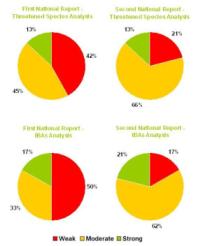
Only 13% of a sample of First and Second National Reports strongly recognise rare and threatened birds and support their conservation through reduction of threats. While, only 17% and 21% of First and Second National Reports respectively gave high priority to conservation of Important Bird Areas, through conserving an effective system of protected areas.

Article 26 of the Convention for Biological Diversity (CBD) states the objective of national reports is to provide information on measures taken to implement the convention and their effectiveness as specified in National Biodiversity Action Plans (NBSAPs). To test the efficacy of these national reports, a sample was examined from the First and Second National Reports (1998 and 2001) in relation to the conservation of globally threatened bird species and Important Bird Areas (IBAs).
Bird species richness and endemism and their relative importance compared to other vertebrates are referred to in the majority of national reports. In some reports special emphasis is put on the number of threatened species including birds. However, in most cases, endemics or emblematic species are presented as a high priority for conservation regardless of their actual threat status. Only 13% of the First and Second National Reports examined strongly recognise rare and threatened birds and support their conservation through reduction of threats. Nevertheless, a comparison of First and Second National Reports shows an improvement in progress with 58% and 79% of parties respectively reporting moderate to strong priority work for conserving threatened and endemic species (and by implication birds).
Protected Areas feature very highly in almost all National Reports, many of which give details on protected area systems and other legal instruments to conserve genetic resources. However, only 17% and 21% of First and Second National Reports respectively gave high priority to conservation of IBAs, through conserving an effective system of protected areas. Furthermore, the emphasis tended to be on sites with forests, wetlands and coastal areas of international importance, with poor consideration for sites with grassland and farmland habitats. However, in the sample of Second National Reports, more than 80% of the parties had undertaken moderate to strong action to conserve Protected Areas (and by implication IBAs).
Links
Compiled: 2008
Recommended Citation:
BirdLife International (2008)
What do the National Reports to the Convention for Biological Diversity tell us?.
Downloaded from https://datazone.birdlife.org/sowb/casestudy/what-do-the-national-reports-to-the-convention-for-biological-diversity-tell-us on 22/12/2024